Home Theater
Surround Sound Formats
Surround sound is available on DVD, Blu-ray, over-the-air TV broadcasts, cable TV, internet streaming services and more. The formats can vary
from 6 channels to 8 channels and with Dolby Atmos, moving audio from speaker to speaker.
Blu-ray Discs can offer higher-fidelity, lossless audio tracks (like Dolby TrueHD) compared to the compressed formats used for internet streaming.
Streaming services primarily use Dolby Digital Plus 5.1 or possibly Dolby Atmos (encoded in DD+ 5.1) to optimize bandwidth while still offering a rich sound experience.
Lossless Audio
These formats provide bit-for-bit identical copies of the studio master:
Dolby TrueHD: Offers up to 8 channels of lossless audio.
DTS-HD Master Audio: Also provides lossless audio, often with high channel counts.
Dolby Atmos & DTS:X: Object-based immersive audio formats that add height channels, often carried within TrueHD or DTS-HD MA streams.
Linear PCM (LPCM): Uncompressed audio, essentially a digital copy of the original analog sound, great for stereo or multi-channel.
Compressed Audio
These formats remove some audio but still retain enough data for the sound to be almost studio quality. These are the most compatible and
provide more efficient transmission.
Dolby Digital (AC-3): Standard surround sound format, also used on DVDs.
Dolby Digital Plus (DD+): An extension of Dolby Digital with higher bitrates and 7.1 channels.
DTS Digital Surround: The standard DTS format, typically 5.1 channels.
DTS-HD (High Resolution): A lossy version of DTS-HD MA, offering better quality than standard DTS but not fully lossless
Compatibility depends on your entire system (TV, A/V receiver, and speakers). Ensure all components
support the desired audio format to get the intended sound effects.
Cable connections: HDMI is required for the high-resolution and spatial audio formats like Dolby TrueHD and Dolby Atmos,
as optical cables do not have enough bandwidth.
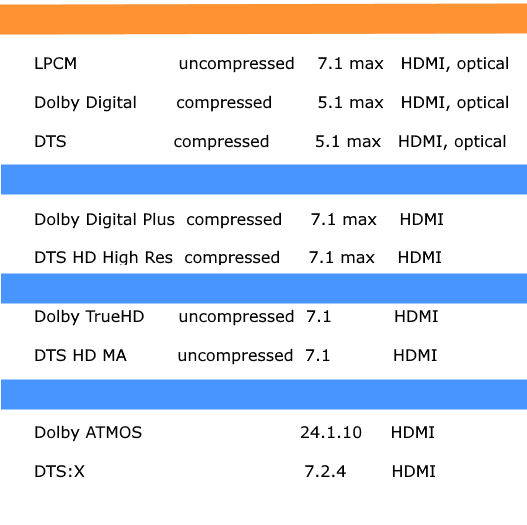
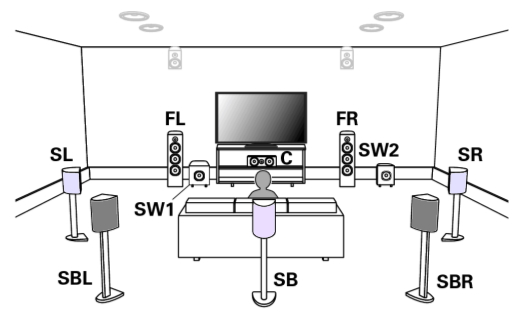
Speaker format is designated as x.y.z where x is the number of full range speakers, y is the number of low frequency speakers and z is
the number of height speakers. Example: 5.1 would be 5 full range speakers and 1 subwoofer. A 7.2 setup would be 7 full range and 2 subwoofers.
When Dolby Atmos is added (true Atmos), one example would be 7.2.4 for 7 surround full range speakers, 2 subwoofers and 4 height speakers.
Surround Sound Speaker Designations
| FL =
Front Left |
1 |
| FR =
Front Right |
2 |
| C =
Center |
3 |
| SL =
Surround Left |
4 |
| SR =
Surround Right |
5 |
| SW =
Subwoofer |
.1 |
| SBL =
Surround Back Left |
6 |
| SBR =
Surround Back Right |
7 |
Surround Sound Formats
| Format |
Channels |
Description
of channels |
| Dolby
Pro Logic |
4 |
- 2 discrete
channels (FL and FR)
- 1 matrixed
channel (C)
- 1 matrixed
channel (SL and SR)
|
| Dolby
Pro Logic II |
5.1 |
- 2 discrete
channels (FL, FR)
- 3 matrixed
channels (C, SL, SR)
- 1 subwoofer
channel
|
| Dolby
Digital |
up
to
5.1 |
- 5 discrete
channels (FL, FR, C, SL and SR)
- 1 discrete LFE
channel (SW)
- Most commercial DVD Video are encoded with Dolby Digital
- Some digital TV audio uses Dolby Digital
|
| DTS |
5.1 |
- 5 discrete
channels (FL, FR, C, SL and SR)
- 1 discrete LFE
channel (SW)
- Some commercial DVD Video are encoded with DTS
|
| Dolby
Digital EX |
6.1,
7.1 |
- 5 discrete
channels (FL, FR, C, SL and SR)
- 1 or 2 matrixed
channel(s)
(SBL), (SBR)
- 1 discrete LFE
channel (SW)
|
| THX
Surround EX |
6.1,
7.1 |
- 5 discrete
channels (FL, FR, C, SL and SR)
- 1 or 2 matrixed
channel(s)
(SBL), (SBR)
- 1 discrete LFE
channel (SW)
|
| DTS-ES |
6.1,
7.1 |
- 6 discrete
channels (FL, FR, C, SL, SR, and SBL)
- 1 discrete LFE
channel (SW)
|
| Dolby Digital Plus |
7.1 max |
- 7 discrete, full-bandwidth channels (front left and right, center, surround left and right, and back left and right surround)
- 1 discrete LFE channel (subwoofer)
- some Blu-ray discs™ are encoded with Dolby Digital Plus
- can be downconverted for playback on a 5.1-channel system
|
| Dolby TrueHD (lossless) |
7.1 max |
- 7 discrete, full-bandwidth channels (front left and right, center, surround left and right, and back left and right surround)
- 1 discrete LFE channel (subwoofer)
- some Blu-ray discs are encoded with Dolby TrueHD
- can be downconverted for playback on a 5.1-channel system
- as a lossless format, offers sound that's "bit-for-bit" identical to the original recording for more detailed, accurate surround sound
|
| DTS-HD™ |
7.1 |
- 7 discrete, full-bandwidth channels (front left and right, center, surround left and right, and back left and right surround)
- 1 discrete LFE channel (subwoofer)
- some Blu-ray discs are encoded with DTS-HD
- can be downconverted for playback on a 5.1-channel system
|
| DTS-HD Master Audio (lossless) |
7.1 |
- 7 discrete, full-bandwidth channels (front left and right, center, surround left and right, and back left and right surround)
- 1 discrete LFE channel (subwoofer)
- some Blu-ray discs are encoded with DTS-HD Master Audio
- can be downconverted for playback on a 5.1-channel system
- as a lossless format, offers sound that's "bit-for-bit" identical to the original recording for more detailed, accurate surround sound
|
|
Dolby Digital and DTS are six-channel (5.1) digital surround sound systems and are currently the standard
soundtracks in major motion pictures (DVD), music, and digital television audio
(HDTV). They both use the 5.1 speaker format.
The format consists of three speakers across the front and two speakers in the
rear. The .1 is a sixth channel called Low-Frequency-Effects and is sent to a
subwoofer.
Dolby ATMOS
Dolby Atmos is a flexible object-based audio system that excels with more speakers but can intelligently
downmix for smaller systems, with 7.1.4 being a popular "gold standard" for home use.
Instead of fixed channels, Atmos sounds are "objects" that the decoder places in 3D space,
so more speakers mean better resolution and immersion, but even fewer (like 2.0.2) can work.
Atmos is metadata that rides in a container audio format such as Dolby Digital Plus or Dolby TrueHD.
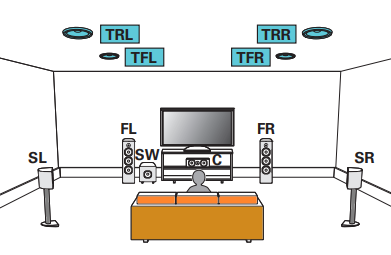
Audio Video Receiver
The AVR processes the audio, decodes, amplifies and sends to the proper speakers. Most modern AVRs can handle Dolby Digital, Dolby Digital Plus,
Dolby TrueHD, DTS, and Dolby Atmos. For Atmos, the AVR can adjust to the speakers available.
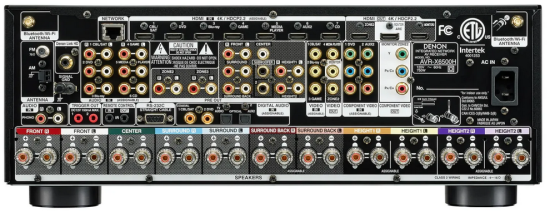
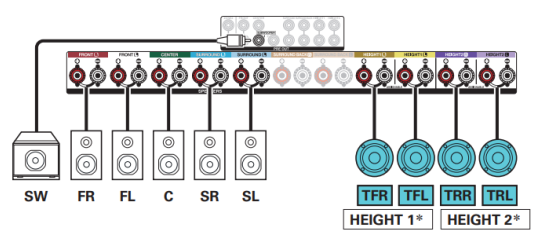

The AVR front panel display will show the channels it is receiving from the source.
Dolby Atmos speaker layouts parallel the 5.1 and 7.1 setups for surround sound but adding overhead speakers or height channels.
A 5.1.2 or 7.1.2 system uses two ceiling speakers, or two Dolby Atmos-enabled speakers or modules.
A 5.1.4 or 7.1.4 system uses four ceiling speakers, or four Dolby Atmos-enabled speakers or modules.
A 9.1.2 system adds a pair of front wide speakers to a 7.1.2 layout.
Rather than specifying discrete channels, a Dolby Atmos soundtrack uses up to 128 audio objects.
Dolby Atmos movie soundtracks will have a 10-channel 7.1.2 bed that will play on any standard 5.1 or 7.1 system. For systems that support Dolby Atmos, it can place a further 118 audio objects anywhere around the 3D sound field – overhead, to the side, front to back, back to front.
This allows specific sound effects to move independently around the room while the channel-based audio bed plays on. On a Blu-ray disc, Dolby Atmos is layered on top of a Dolby TrueHD soundtrack.
A system that doesn’t support Atmos will play the standard high-resolution TrueHD audio, while on Atmos-enabled hardware, the extra Atmos metadata will add to the mix.
Three audio codecs support Dolby Atmos metadata:
Dolby TrueHD (up to 24bit/96kHz)
Dolby Digital Plus (48kHz)
Dolby MAT (lossless PCM)
Atmos metadata is layered on Dolby Digital Plus audio for terrestrial TV and streaming services, as this uses less bandwidth. They don’t support high-resolution audio like Dolby TrueHD.
Most people will want to use Atmos with a surround sound layout, so the most common format for a small system would be 5.1.2.
However, these are the minimum requirements, and for the best 3D effect, Dolby recommends installing at least four height speakers.
An Atmos speaker layout can be up to a maximum of 24.1.10.
To get Atmos on your smart TV, you will need three things:
A streaming service that supports Atmos
A TV that can play Dolby Atmos (via an HDMI ARC connection)
A sound system capable of playing Atmos
Streaming devices that support Dolby Atmos:
Apple TV 4K
Amazon Fire TV Stick
Amazon Fire TV Cube
Amazon Fire TV Stick 4K
Roku Ultra
Roku Ultra 4K
Roku Streaming Stick+
Nvidia Shield TV PRO
Nvidia Shield TV
Chromecast With Google TV
Surround sound
loudspeaker setup: 5.1 surround sound format
HOME THEATER
Surround Sound Formats Explained:
There are two ways to deliver a surround sound signal. The older analog
matrix technology works by mixing (matrixing) multiple channels into
two main channels; the matrixed information then has to be decoded into the
original channel configuration. The newer digital
discrete technology keeps all the channels separate, producing a more
clearly isolated surround effect.
Most newer audio/video receivers contain
multiple surround sound decoders, and handle all the format-switching
automatically. But you still might need to know what you're dealing with, so see
the description below for a basic guide to surround sound formats.
Matrixed Surround Sound
Formats
Surround sound was first heard via a matrixed technologythe
original Dolby Surround format. Matrix technology has become more effective over
the years, but still isn't as realistic as discrete surround sound. We've seen three different matrix technologies in the home, all analog, and all from Dolby
Laboratories.
Dolby Surround
The original surround sound format for home video was Dolby Surround.
This is a simple three-channel format, with left, right, and surround channels.
The surround channel is matrixed into the left and right channels; the Dolby
Surround decoder separates the surround channel from the mix and runs it into
one or two surround speakers. When you use two surround speakers, they both play
the same surround channel.
Dolby Surround was first used in some prerecorded videotapes, and in some
augmented stereo television broadcasts. It's not used much today.
Dolby Pro Logic
Dolby Pro Logic is a more sophisticated version of Dolby Surround. Pro
Logic adds a center channel to the mix; it's a four-channel system with left,
center, right, and surround channels. The center and surround channels are
matrixed into the left and right channel information, and then separated out
with a decoder. As with Dolby Surround, the single Dolby Pro Logic surround
channel is often fed to two surround speakers, which both play the same track.
Dolby Pro Logic is the surround technology used in many television, cable,
and satellite broadcasts, as well as in most prerecorded videotapes. It's still
in use today.
Dolby Pro Logic II
Dolby Pro Logic II is a version of Dolby Pro Logic with a different
purpose. This surround format is designed to simulate a surround effect from a
two-channel source. You use Dolby Pro Logic II to play stereo soundtracks and
CDs on a surround sound system. (The newer Dolby Pro Logic IIx format applies
the same technology to 7.1-channel systems.)
The Discrete Surround Sound
Formats
Discrete surround sound keeps each channel separate.
Dolby Digital
The most popular discrete surround sound format today is Dolby Digital. As
the name implies, it's a digital process, unlike the analog
matrix technology used in the older Dolby Pro Logic format.
Dolby Digital is used in most commercial DVD soundtracks as well as some satellite
TV and
cable TV programming, and is
the format specified for all HDTV broadcasts. In short, it's the surround sound format
of choice today.
There are actually several variations of Dolby Digital, depending on how many
channels are used. Dolby Digital is actually a flexible format
that supports up to 5.1 channels. So mono films are often recorded in Dolby
Digital 1.0 (one center channel, no subwoofer), and older stereo films in Dolby
Digital 2.0 (left and right front channels, no subwoofer).
The most common format, however, is Dolby Digital 5.1. This format includes
left front, center front, right front, left surround, and right surround
channels, plus a separate low frequency effects (LFE) channel that is fed to
your subwoofer. Add that up and you get the 5 main channels plus the
".1" LFE channel.
DTS
The Digital Theater Systems company markets a discrete surround format,
called DTS, that competes
head-to-head with Dolby Digital. Like Dolby Digital 5.1, the DTS format includes
five main channels (left front, center front, right front, left surround, and
right surround) plus a separate LFE channel.
DTS works much like Dolby Digital, but with higher data rates. This
results, to some ears, in slightly better sound quality. DTS is an optional format in the home theater environment. There are far more DVDs with Dolby Digital
soundtracks than with DTS soundtracks. Most A/V receivers include both Dolby
Digital and DTS decoders, however, and will automatically detect DVDs with DTS
soundtracks.
Dolby Digital EX
Dolby Digital EX is a variation of the Dolby Digital format. EX
adds a "surround rear" channel in addition to the regular left and
right surrounds. This rear channel is placed behind the listener, while
the left and right surrounds are placed to the sides. Note, however, that this
surround channel is matrixed, not discrete, so it's not overly directional.
There are actually two variations of Dolby Digital EXthe original
6.1-channel format (with a single matrixed rear channel) and the newer
7.1-channel format (with matrixed rear left and rear right channels).
Dolby Digital EX is sometimes referred to as THX Surround EX,
as it has THX certification. Learn more about THX here.
DTS ES
Like Dolby Digital EX, DTS ES is a 6.1 technology with an added
surround rear channel. There is also a 7.1-channel version, with two surround
rear channels. Both versions use matrix technology to create and decode the rear
channel(s).
DTS ES Discrete
If matrixed surround channels aren't ideal to your ears, check out the DTS
ES Discrete system. Unlike both Dolby Digital EX and DTS ES, DTS ES Discrete
uses discrete technology for its single rear channel. The rear channel in ES
Discrete is thus more distinct from the side surrounds than with the other
6.1-channel formats.
:::
Discrete Surround Sound Formats... more details
Dolby
Digital or AC3 Dolby Digital is a compressed discrete surround sound
format that is dominant on DVD-Video movies and is frequently found on DVD-Audio
discs. Most receivers and A/V Preamps are capable of decoding Dolby Digital.
Dolby Digitals main advantage is that it can fit in places where uncompressed
surround sound simply wouldnt go. One of those places is on some satellite TV
broadcasts. You do need a Dolby Digital-capable DSS (digital satellite)
receiver, but it is nice to get movies from the dish in surround. Music
enthusiasts argue that the 12:1 compression on Dolby Digital loses a little too
much audio quality as compared to other lossy surround sound formats like
DTS.
DTS
DTS was developed for Jurassic Park in 1993 and is the main competitor
to Dolby Digital in the A/V market. DTS advantage over Dolby is its 3:1
compression versus 12:1. While the sound is often better, studio and record
labels have to decide if they want to sacrifice supplemental material on a DVD
in place of better surround sound. DTS has produced many of their own musical
titles on CD, DVD and DVD-Audio that feature their surround sound format: DTS
CDs can be played on any CD player with a digital output or on a DVD player.
MLP
MLP stands for Meridian Lossless Packing. It is the Lossless
compression scheme used on DVD-Audio to get the highest resolution surround
sound and stereo music from a DVD disc.
DSD
Found exclusively on SACDs (Super Audio CD), Sony and Philips DSD format
uses a different recording and compression scheme than the PCM (Pulse Code
Modulation) used by DVD-Audio and all other digital media.
5.1 5.1 consists of the five surround speakers (center, two
fronts, two sides/rears), plus a subwoofer. Because in early systems the Low Frequency Effects (LFE) channel was limited only to low
frequencies, it was referred to as .1. The LFE channel
is often referred to as the subwoofer channel.
The LFE channel on a DVD does not go to the subwoofer -- it goes into your
systems bass management. Similarly, the subwoofer doesnt just receive
signals from the LFE, but instead receives all the bass from all channels that
your other speakers cant reproduce, thanks to the bass management system.
DTS
ES (6.1) DTS has a format that most frequently adds a rear center
speaker to the surround sound package found on selected music and movie discs.
THX
EX (7.1) if you have the discs and a preamp that can play 7.1, you
can add more speakers to your system to increase your systems ability to
resolve detailed and complex surround effects from more modern films. THX EX
suffers from the same problem as DTS ES, people are hard-pressed to name any movies in the format.
:::
Quadraphonic While quad was commercially not a huge success,
mainly because of the limitations of vinyl as a surround sound medium, many recordings were made in quad during the 1970s. Some of these have been
released on DTS CDs. Others made their way to SACD or DVD-Audio.
Matrix Surround
In the days before multi-channel digital audio systems like DVD, surround
(originally quad, but later other systems as well) had to be squeezed into two
channels for compatibility with stereo broadcasts and albums. This was never as
good as having extra real channels, but as few people actually had
four-channel tape recorders or record players, it was the best that could be
done. The process of squeezing four or more channels into two and then trying to
get them back again at the receiving end is called matrixing and the
systems that do this are called Matrix Surround systems. Dolby, because of
their prominence in the film world, became the leader at this with Dolby Pro
Logic and Pro Logic II.
Many TV broadcasts are actually transmitted in surround using this system
look for messages at the beginning saying, in surround where available
and if you switch your receiver to Pro Logic or Pro Logic II, you
will be able to listen in surround. The Pro Logic decoder in your receiver or
preamp will also do a fair job of creating a surround effect from ordinary
stereo material.
Pro Logic II is leaps and bounds ahead of the old Dolby Pro Logic. Pro Logic II
can add significant information to your rear speakers, which really adds to
watching satellite TV, digital cable, watching movies from
a VCR and more.
:::
• Home Theater Receivers
See also:
• Video Cables Connections
• See over 100 Hookup Diagrams
Columbia ISA Audio Video
Empowering consumers through information
Contact: columbiaisa@yahoo.com
|







